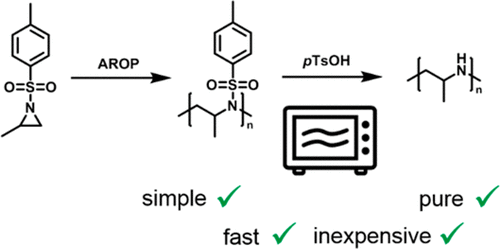当前位置:
X-MOL 学术
›
ACS Macro Lett.
›
论文详情
Our official English website, www.x-mol.net, welcomes your
feedback! (Note: you will need to create a separate account there.)
Microwave-Assisted Desulfonylation of Polysulfonamides toward Polypropylenimine
ACS Macro Letters ( IF 5.1 ) Pub Date : 2018-05-07 00:00:00 , DOI: 10.1021/acsmacrolett.8b00180 Elisabeth Rieger 1 , Tassilo Gleede 1 , Angelika Manhart 1 , Markus Lamla 2 , Frederik R Wurm 1
ACS Macro Letters ( IF 5.1 ) Pub Date : 2018-05-07 00:00:00 , DOI: 10.1021/acsmacrolett.8b00180 Elisabeth Rieger 1 , Tassilo Gleede 1 , Angelika Manhart 1 , Markus Lamla 2 , Frederik R Wurm 1
Affiliation

|
Linear polyethylenimine (L-PEI) has been the gold standard for gene delivery and is typically prepared by hydrolysis from poly(2-oxazoline)s. Recently, also the anionic polymerization of activated aziridines was reported as a potential pathway toward linear and well-defined polyamines. However, only sulfonamide-activated aziridines so far undergo the living anionic polymerization and their desulfonylation was only reported scarcely. This is mainly due to the relatively high stability of the sulfonamides and the drastic change in solubility during the desulfonylation. Herein, we investigated the desulfonylation of such poly(aziridine)s prepared from tosylated or mesylated propyleneimine to afford linear polypropylenimine (L-PPI) as an alternative to L-PEI. Different desulfonylation strategies for tosylated (Ts) and mesylated (Ms) PPI were studied. The reductive cleavage of the sulfonamide with sodium bis(2-methoxy ethoxy) aluminum hydride yielded 80% of deprotected amine groups. Quantitative conversion to L-PPI was obtained, when the tosylated PPI was hydrolyzed under acidic conditions with pTsOH under microwave (MW) irradiation. The same treatment removed 90% of the mesyl groups from the mesylated PPI analog. The MW-assisted acidic hydrolysis represents a fast, inexpensive and easy approach in comparison to other methods, where complex reaction conditions and tedious purifications are major drawbacks, however some chain scission may occur. The high purity of the obtained products, in combination with the versatility of the activated aziridine chemistry, demonstrate many advantages of our strategy, especially for future biomedical implementations.
中文翻译:

聚磺酰胺对聚丙烯亚胺的微波辅助脱磺酰化
线性聚乙烯亚胺 (L-PEI) 一直是基因传递的金标准,通常由聚 (2-恶唑啉) 水解制备。最近,活性氮丙啶的阴离子聚合也被报道为形成线性和明确定义的多胺的潜在途径。然而,到目前为止,只有磺胺活化的氮丙啶进行活性阴离子聚合,并且它们的脱磺酰基作用很少见报道。这主要是由于磺胺类药物相对较高的稳定性和脱磺酰化过程中溶解度的剧烈变化。在此,我们研究了由甲苯磺酰化或甲磺酰化丙烯亚胺制备的这种聚(氮丙啶)的脱磺酰化,以提供线性聚丙烯亚胺 (L-PPI) 作为 L-PEI 的替代品。研究了甲苯磺酸化 (Ts) 和甲磺酸化 (Ms) PPI 的不同脱磺酰化策略。磺酰胺用双(2-甲氧基乙氧基)氢化铝钠还原裂解产生80%的去保护胺基团。当甲苯磺酰化的 PPI 在酸性条件下水解时,得到 L-PPI 的定量转化p TsOH 在微波 (MW) 照射下。相同的处理从甲磺酰基化的 PPI 类似物中去除了 90% 的甲磺酰基。与其他方法相比,MW 辅助酸性水解代表了一种快速、廉价和简单的方法,其中复杂的反应条件和繁琐的纯化是主要缺点,但可能会发生一些断链。所获得产品的高纯度,结合活化氮丙啶化学的多功能性,展示了我们战略的许多优势,特别是对于未来的生物医学实施。
更新日期:2018-05-07
中文翻译:

聚磺酰胺对聚丙烯亚胺的微波辅助脱磺酰化
线性聚乙烯亚胺 (L-PEI) 一直是基因传递的金标准,通常由聚 (2-恶唑啉) 水解制备。最近,活性氮丙啶的阴离子聚合也被报道为形成线性和明确定义的多胺的潜在途径。然而,到目前为止,只有磺胺活化的氮丙啶进行活性阴离子聚合,并且它们的脱磺酰基作用很少见报道。这主要是由于磺胺类药物相对较高的稳定性和脱磺酰化过程中溶解度的剧烈变化。在此,我们研究了由甲苯磺酰化或甲磺酰化丙烯亚胺制备的这种聚(氮丙啶)的脱磺酰化,以提供线性聚丙烯亚胺 (L-PPI) 作为 L-PEI 的替代品。研究了甲苯磺酸化 (Ts) 和甲磺酸化 (Ms) PPI 的不同脱磺酰化策略。磺酰胺用双(2-甲氧基乙氧基)氢化铝钠还原裂解产生80%的去保护胺基团。当甲苯磺酰化的 PPI 在酸性条件下水解时,得到 L-PPI 的定量转化p TsOH 在微波 (MW) 照射下。相同的处理从甲磺酰基化的 PPI 类似物中去除了 90% 的甲磺酰基。与其他方法相比,MW 辅助酸性水解代表了一种快速、廉价和简单的方法,其中复杂的反应条件和繁琐的纯化是主要缺点,但可能会发生一些断链。所获得产品的高纯度,结合活化氮丙啶化学的多功能性,展示了我们战略的许多优势,特别是对于未来的生物医学实施。











































 京公网安备 11010802027423号
京公网安备 11010802027423号